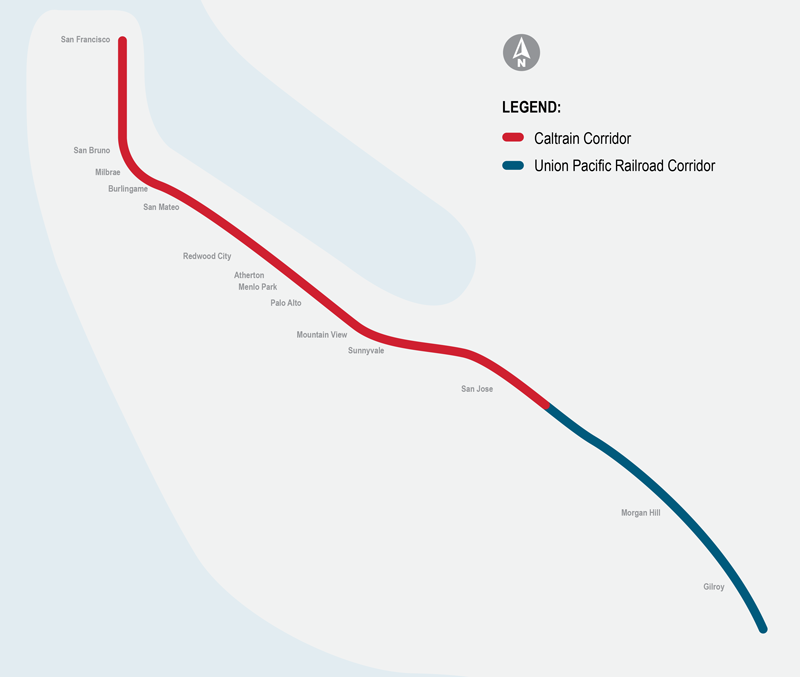1. What is an at-grade crossing, a grade separation, a grade crossing closure, and a pedestrian-only crossing?
- At-Grade Crossing: An intersection where a roadway and a railroad cross each other at the same level. Traffic must stop when trains are passing by.
- Grade Separated Crossing: A location where the roadway and the railroad do not cross each other, and the railroad is either above or below the roadway. Without the conflict with the railroad, multi-modal traffic can flow freely.
- Closed Crossing: A location where the roadway and the railroad previously crossed each other, but the roadway is turned into dead ends on both sides of the tracks. This type of crossing may maintain or provide new mobility for non-vehicular modes such as pedestrians and bicyclists.
- Bike/Pedestrian Only Crossing: A separate bicycle/pedestrian only crossing is a separate sidewalk or pathway where bicyclists and/or pedestrians can safely cross railroad tracks, no vehicle access is permitted.
2. What are the benefits of grade separations or closures?
- Improved Safety: Eliminates conflicts between trains, vehicles, and active transportation to improve safety for multi-modal travelers.
- Reduced Noise: Grade separations or closures eliminate the need for train horns to sound when approaching an at-grade crossing, reducing noise for the surrounding community.
- Decrease in Traffic Congestion: Congestion decreases with a grade separation or closure, since vehicle and active transportation travelers are not left waiting at railroad gate arms.
- Reduction in GHG Emissions: Closing or grade separating a crossing reduces GHG emissions, due to vehicles not needing to idle because of passing rail traffic.
- Improve Train Operations Reliability: Train operations reliability improves with a grade separation or closure, since trains do not have to stop or slow down due to other travel.
- Enhanced Community Connectivity: Community connectivity and multi-modal transit opportunities improve with the removal of the conflict with the train corridor, allowing for smooth travel across the railway.
3. Who are the current corridor operators?

4. What is the difference between Union Pacific Railroad (UPRR) and the Joint Powers Board (JPB) Right-of-Way?
Caltrain operates from San Francisco to Gilroy and, owns the corridor through the Tamien Station located in the City of San Jose. Just south of Tamien Station, ownership transfers to the Union Pacific Railroad. Since Caltrain operates but does not own the southern corridor, construction on this corridor needs to follow UPRR policies and standards.

Current Grade Separation Project Delivery Process
The below sections explain elements of the current crossing closure and modification project delivery process. The Corridor Crossings Strategy will identify opportunities for improvement across all aspects of the project delivery process.
5. What is the project delivery process of grade crossing projects?
The process of grade crossing projects includes a few key steps:
- Project Initiation by the Project Sponsor (typically the city in which the crossing is located)
- Planning, evaluating crossing alternatives, and selecting the locally preferred alternative
- Designing the alternative to Caltrain and local design standards
- Constructing the alternative while educating the public about the new crossing
- Opening the crossing to the public
6. How are crossing closure and separation projects funded?
Caltrain is funded only for the operations and maintenance of the railroad. Typically, the city/jurisdiction initiates the crossings closure or modification. As the project sponsor, the city is responsible for preparing and executing a funding plan for the Project’s design and construction. There are funding programs at the county, state and federal level available, but they do not meet the current corridor-wide demand. There are currently three (3) local County funding programs, as described below:
San Mateo County Transportation Authority (SMCTA) Measure A Funding Program. Available for SamTrans, San Mateo County and cities, and the JPB, Measure A has provided $109 million in funding to date, and there is an estimated $116 million remaining to fund eligible grade separation projects until 2033. Link: https://www.smcta.com/about-us/funding-overview/measure.
SMCTA Measure W Funding Program. Available for SamTrans, San Mateo County and cities, and the JPB, Measure W is estimated to allocate $68 million over the 30 year lifespan of the measure. Link: https://www.smcta.com/about-us/funding-overview/measure-w
Santa Clara Valley Transportation Authority (VTA) Measure B Funding Program. Available to enhance transit, highways, expressways, and active transportation (bicycles, pedestrians, and complete streets) within Mountain View, Palo Alto, and Sunnyvale, Measure B is estimated to allocate approximately $700 million over the 30-year lifespan of the measure. Currently, 2 projects (Castro Grade Separation and CSS) have received Measure B funding of $11 million to date. $42 million dollars have been allocated in the 2023 Fiscal Year for the Castro Grade Separation. Link: https://www.vta.org/projects/funding/2016-measure-b
The Corridor Crossings Strategy (CCS) will better define opportunities for project funding and better position crossing projects for additional funding, to facilitate the delivery of grade separations.
7. What is the standard timeline of a crossing closure or modification?
On average, a grade separation project on the railroad takes approximately 10 years to as much as 15 years. The duration of a grade separation project, from initial planning to construction close out, varies greatly depending on a few key factors: the size of grade separation, funding availability, community acceptance, right-of-way acquisition, and utility relocation needed.
Caltrain reports on the status of all projects, including grade separation projects, quarterly. The reports can be found here.
